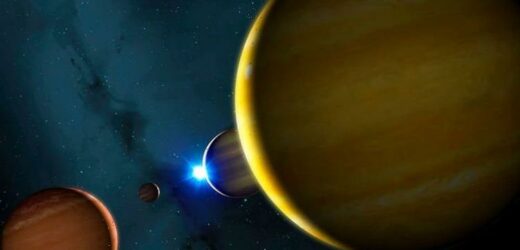European Space Observatory discusses ‘Stranger Exoplanets’
We use your sign-up to provide content in ways you’ve consented to and to improve our understanding of you. This may include adverts from us and 3rd parties based on our understanding. You can unsubscribe at any time. More info
A planet is round because of gravity; its gravity pulls equally from all sides, from the centre to the edges like the spokes of a bicycle wheel. The result is an overall sphere, a three-dimensional circle. The biggest differences between planets come from other things like their size, their terrain, their chemical makeup and distance to their star.
However, a recent discovery made by the European Space Agency’s (ESA) exoplanet-hunting satellite Cheops has thrown this previously undisputed conclusion on its head.
Scanning the Universe for exoplanets — those worlds outside our Solar System — it caught sight of a planet deformed by the strong tidal pull of its host star.
Named WASP-103b, the planet is located around 35 light-years from Earth.
It is in the constellation of Hercules, and is about twice the size of Jupiter and 1.5 times its mass.


The planet is so close to its host star, WASP-103, which is around 200˚C and 1.7 times larger than the Sun, that it completes a full orbit in less than a day, its tides far more extreme than those seen on Earth.
Astronomers have long believed that such a close proximity would cause a planet to experience a strong tidal pull from its host star.
The NASA/ESA Hubble Space Telescope and NASA’s Spitzer Space Telescope had already observed the planet
But up until now researchers had not been able to take a measurement.
JUST IN: World holds breath as Ukraine to fire rocket amid Russia tension

Cheops, the groundbreaking satellite launched in 2019 to determine the size of known extrasolar planets, has allowed scientists to estimate their mass, density, composition and formation.
In order to measure the exoplanets’ transits, it looks at the dip in light caused when they pass in front of their star.
The satellite’s high precision of measurement of WASP-103b over multiple transits enabled researchers to determine that the gravitational pull of its host star is strong enough to stretch the planet out into the shape of a rugby ball.
Susana Barros, a lead researcher of the study from the Instituto de Astrofísica e Ciências do Espaço and University of Porto, Portugal, told BBC Science Focus magazine how the gravitational pull signaled to the scientists what the exoplanet was made of, and, importantly, its shape.
DON’T MISS
Macron slammed for posturing over Brexit as he blows top over Galileo [REPORT]
EU Galileo blow as UK’s OneWeb network signs major deals [INSIGHT]
Boris on brink: Red Wall poll signal end of the road for PM [ANALYSIS]


She said: “The resistance of a material to being deformed depends on its composition.
“For example, here on Earth we have tides due to the Moon and the Sun but we can only see tides in the oceans.
“The rocky part doesn’t move that much.
“By measuring how much the planet is deformed we can tell how much of it is rocky, gaseous or water.”

The researchers were able to use the data collected by Cheops to determine WASP-103b’s Love number – a measure of how mass is distributed within a planet.
The Love number for WASP-103b is similar to that of Jupiter’s.
This suggests that the internal structure is similar, despite WASP-103b having twice the radius, researchers say.
Now, the team hopes to study the planet further by using observations taken by Cheops combined with the newly launched James Webb Space Telescope.

They believe that this will help to shed further light on its internal structure.
Jacques Laskar, a co-author of the research based at the Paris Observatory, Université Paris Sciences et Lettres, said: “It’s incredible that Cheops was actually able to reveal this tiny deformation.
“This is the first time such analysis has been made, and we can hope that observing over a longer time interval will strengthen this observation and lead to better knowledge of the planet’s internal structure.”
Source: Read Full Article


